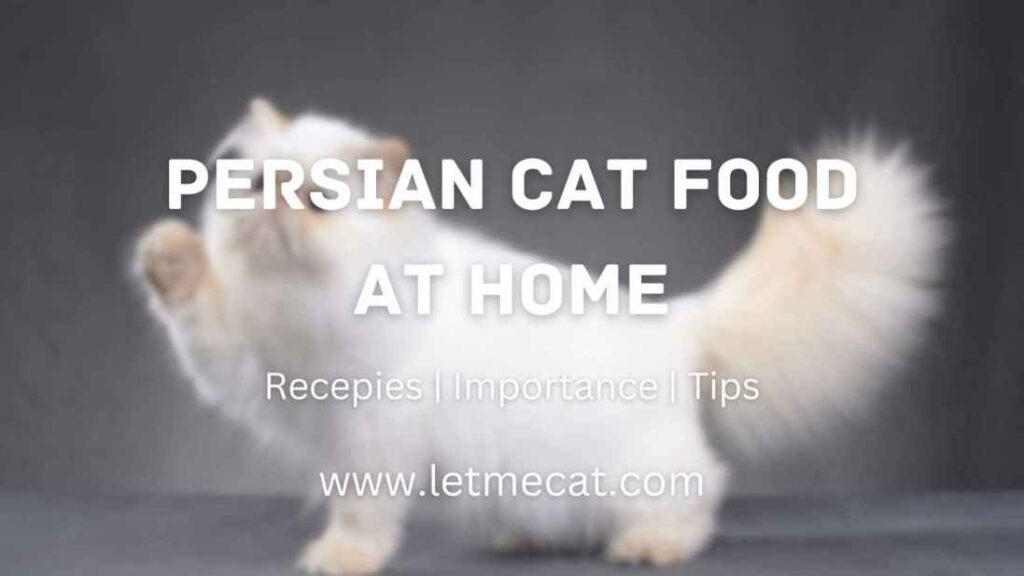This article will explore homemade Persian cat food, ensuring they receive the necessary nutrients for optimal health and happiness.
We’ll discover the benefits of homemade Persian cat food recipes and balanced diets. We’ll learn about the nutritional needs of Persian cats, including protein requirements, healthy fats, and essential vitamins.
We’ll also discuss how to consult a veterinarian and get tips for transitioning your cat to a homemade diet. Explore recipe ideas, and feeding guidelines, and avoid harmful foods. Ensure your Persian cat’s health and well-being with homemade meals tailored to their needs.
So, let’s jumpy right into it.
Understanding the Nutritional Needs of Persian Cats
To create a well-balanced homemade diet for your Persian cat, it’s essential to understand its nutritional requirements. Here are the key elements to consider:
1. Protein Requirements
Protein is crucial for Persian cats as obligate carnivores. It aids in muscle development, supports the immune system, and promotes healthy skin and coat. Include high-quality animal proteins like chicken, turkey, or fish in their diet.
2. Healthy Fats and Oils
Persian cats require healthy fats and oils for energy and the absorption of fat-soluble vitamins. Incorporate sources like fish oil, olive oil, or flaxseed oil to ensure a well-rounded diet.
3. Essential Vitamins and Minerals
Vitamins and minerals play a vital role in a Persian cat’s overall health. Ensure their diet includes appropriate amounts of vitamin A, vitamin E, taurine, calcium, and phosphorus. These nutrients can be found in lean meats, fruits, and vegetables.
4. Water Intake
Persian cats are prone to urinary tract issues, making hydration crucial. Provide fresh water at all times and consider moist foods to help increase their overall water intake.
Homemade Diets for Persian Cats
Before starting a homemade diet for your Persian cat, it’s essential to consult a veterinarian. They can guide you in creating a balanced meal plan that meets your cat’s specific needs. Some homemade diet options to consider include:
1. Importance of Consulting a Veterinarian
Working closely with a veterinarian is crucial when designing a homemade diet. They can help tailor the diet to your cat’s age, weight, and any specific health concerns.
2. Balanced Homemade Diets
A balanced homemade diet for a Persian cat should consist of a combination of protein, carbohydrates, and healthy fats. Ensuring the right ratios of these components is vital for their overall well-being.
3. Raw Food Diet
Raw food diets for cats mimic their natural eating habits. However, it requires careful preparation to eliminate potential bacterial contamination and nutrient imbalances.
4. Food Diet
Cooked food diets can provide a safer option for homemade meals. Ensure the ingredients are cooked thoroughly while preserving the necessary nutrients.
Recipe Ideas for Homemade Persian Cat Food
Preparing homemade food for your Persian cat can be a creative and enjoyable experience. Here are a few recipe ideas to get you started:
1. Chicken and Rice Delight
This recipe combines lean chicken, cooked rice, and a small amount of vegetables like peas or carrots. Cook the chicken thoroughly and mix it with cooked rice for a nutritious meal.
2. Fish and Sweet Potato Stew
A fish-based stew with sweet potatoes can be a tasty option for your Persian cat. Cook the fish, remove any bones, and mix it with mashed sweet potatoes for a flavorful and nutritious meal.
3. Turkey and Quinoa Surprise
Combine cooked ground turkey with cooked quinoa for a protein-packed meal. Add a small amount of steamed vegetables like spinach or green beans for added nutrients.
Feeding Guidelines and Tips
When feeding your Persian cat homemade food, it’s essential to follow these guidelines:
1. Portion Control
Monitor your cat’s weight and adjust portion sizes accordingly. Overfeeding can lead to obesity, while underfeeding can result in malnutrition.
2. Ingredient Quality and Sourcing
Ensure the ingredients used in homemade meals are of high quality. Opt for organic or human-grade ingredients when possible to minimize potential toxins or additives.
3. Dietary Supplements
Discuss with your veterinarian if your Persian cat needs any dietary supplements to complement their homemade diet. They can guide you on appropriate supplementation.
Avoiding Harmful Foods
Certain foods can be harmful or even toxic to cats. Be aware of the following:
1. Toxic Foods for Cats
Foods like chocolate, onions, garlic, and grapes can be toxic to cats and should be strictly avoided.
2. Allergenic Ingredients to Avoid
Some cats may have specific food allergies. Monitor their reactions to certain ingredients and avoid those that cause adverse symptoms.
3. Human Foods to Steer Clear of
While sharing food with your cat may be tempting, it’s best to avoid giving them foods intended for human consumption. Stick to their specific dietary needs.
Transitioning to Homemade Food
Transitioning your Persian cat to a homemade diet requires a gradual approach. Follow these steps for a successful transition:
1. Gradual Transitioning Process
Start by mixing small amounts of homemade food with their regular diet. Gradually increase the proportion of homemade food while decreasing the commercial food until they are solely on the new diet.
2. Monitoring and Adjusting
Monitor your cat’s weight, energy levels, and overall health during the transition. Make adjustments to the diet as necessary in consultation with your veterinarian.
3. Signs of a Successful Transition
A successful transition to a homemade diet is marked by a healthy weight, shiny coat, improved digestion, and overall well-being.
Conclusion
Preparing homemade food for your Persian cat can be a fulfilling way to ensure their nutritional needs are met. By understanding their requirements, consulting a veterinarian, and following appropriate recipes, you can provide a balanced and wholesome diet tailored to your cat’s needs. Remember to monitor their health and seek professional guidance when needed.
Thank you for reading this post.




Pingback: Persian Cat Baby Food: The Nutritional Needs - Let Me Cat